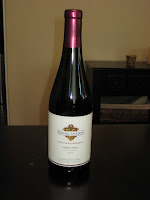In this weeks tasting, we will be exploring the tannic element of wine. Tannins are a normal component found in the skins, stems and seeds of grapes and when steeped, the juice soaks up the red color along with the tannins when making red wine. Tannin is more of a texture that you feel in your mouth rather than a flavor. Robinson compares the feeling on the tongue to accidentally biting the stringy part of the banana peel rather than the banana. It is drying and makes you feel like puckering your mouth.
The intensity of tannin varies depending on type of red grape. Grapes with thicker skins, such as Cabernet Sauvignon, have more tannin than grapes with thinner skins such as Pinot Noir. The color of wine follows the same guidelines so the darker the color of a red wine, the more tannin. Tannin can also vary with the amount of skin contact the juice has. The longer the juice soaks with the skins, the more tannic the wine will be. Aging wine can actually reduce the intensity of the tannins leaving a smooth and more balanced wine.
As with the last tasting, we tasted a wine with and without this characteristic. Robinson suggests tasting a low-tannin Pinot Noir and a high-tannin Cabernet Sauvignon. Out of the list of wines provided, I chose the 2008 Kendall-Jackson Pinot Noir from California and the 2007 Franciscan Estate Cabernet Sauvignon from Napa Valley.
The Pinot was a very translucent ruby color and the Cab was a deep reddish-purple. The Pinot had a subtle fragrance with a very smooth and silky taste. I'm sure this is why Pinot Noir is so popular....it definitely seems versatile and not overwhelming to the average drinker. The Cab was much more intense in smell and in flavor. It was a little tangy and was definitely more dry to the point of drying out my entire mouth. In the pictures below, the Pinot Noir is on the left and the Cabernet Sauvignon is on the right.
Robinson says that this tannin character is the reason Cabernet Sauvignons go so well with steak or cheese. She says that the fats in the protein coat your tongue and allow the tannins to pass over your mouth without completely drying it out. I can't wait to learn more about pairing wine with food!







